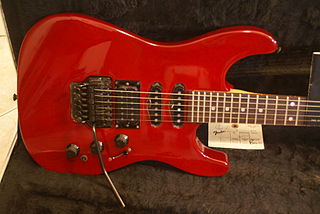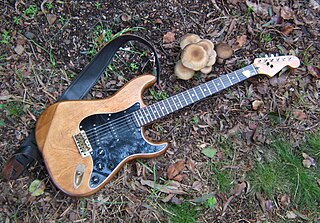Ibanez is a Japanese guitar brand owned by Hoshino Gakki. Based in Nagoya, Aichi, Japan, Hoshino Gakki were one of the first Japanese musical instrument companies to gain a significant foothold in import guitar sales in the United States and Europe, as well as the first brand of guitars to mass-produce the seven-string guitar and eight-string guitar. Ibanez manufactures effects, accessories, amps, and instruments in Japan, China, Indonesia and in the United States. As of 2017 they marketed nearly 165 models of bass guitar, 130 acoustic guitars, and more than 300 electric guitars. After Gibson and Fender, Ibanez is considered the third biggest guitar brand.

The baritone guitar is a guitar with a longer scale length, typically a larger body, and heavier internal bracing, so it can be tuned to a lower pitch. Gretsch, Fender, Gibson, Ibanez, ESP Guitars, PRS Guitars, Music Man, Danelectro, Schecter, Jerry Jones Guitars, Burns London and many other companies have produced electric baritone guitars since the 1960s, although always in small numbers due to low popularity. Tacoma, Santa Cruz, Taylor, Martin, Alvarez Guitars and others have made acoustic baritone guitars.

Superstrat is a name for an electric guitar design that resembles a Fender Stratocaster but with differences that clearly distinguish it from a standard Stratocaster, usually to cater to a different playing style. Differences typically include more pointed, aggressive-looking body and neck shapes, different woods, increased cutaways to facilitate access to the higher frets, increased number of frets, contoured heel facilitating easier higher fret access, usage of humbucking pickups and locking vibrato systems, most commonly the Floyd Rose.

Cimar was a Hoshino Gakki guitar brand. Designs of Cimar guitars are sometimes very similar to Hoshino Gakki's Ibanez guitar brand. Cimar guitars appear in Hoshino Gakki catalogues.

Christopher John Holmes is an American heavy metal guitarist and songwriter. Holmes started his musical career in the Pasadena, California area in the late 1970s and early 1980s. He is best known as the lead guitarist of heavy metal band W.A.S.P. Together with Blackie Lawless and Randy Piper he was one of the founding members of the band. Holmes was a member of W.A.S.P. first from 1983 to 1990, and again from 1996 to 2001.

The Frankenstrat, also known as "Frankie", is a guitar created by Eddie Van Halen. Its name is a portmanteau of Frankenstein, the fictional doctor who created a monster by combining body parts of the recently deceased, and the Stratocaster, a model of electric guitar made by Fender.

Orville by Gibson (オービルbyギブソン), the models with only Orville (オービル) were made after Gibson ended the contract with leftover parts, was a brand of guitars that was managed by the Gibson Guitar Corporation for the Japanese market during the late 1980s and most of the 1990s. The name is borrowed from Orville Gibson, who founded Gibson in 1902.

The Ibanez RG is a series of electric guitars produced by Hoshino Gakki and one of the best-selling superstrat-style guitars ever made. The first model in the series, the RG550, was originally released in 1987 and advertised as part of the Roadstar series. That series was renamed "RG" in 1992 and all models since are simply known as RGs.

Greco is a Japanese guitar brand owned by the Kanda Shokai Corporation (in Japanese) 神田商会, a musical instrument wholesaler mostly known for being part of Fender Japan. Instruments manufactured with the name "Greco" are electric and acoustic guitars.

The Ibanez Iceman is a guitar produced by Hoshino Gakki under Ibanez brand.
Hoshino Gakki Co., Ltd. is a Japanese manufacturer of musical instruments. It is the owner of the Ibanez guitar and Tama drum brand names.

FujiGen Gakki, also known as FGN, is a Japanese musical instrument manufacturing company based in Matsumoto, Nagano. The company is named after Japan's iconic Mount Fuji. "Gen" means stringed instruments and "Gakki" means musical instrument – the name is literally translated to "Fuji Stringed Musical Instruments". FujiGen does OEM guitar manufacturing for well known guitar brands and they also manufacture their own brand of guitars known as FGN.
Salvador Ibáñez (1854–1920) was a Spanish luthier. He made guitars, ukuleles, mandolins and other stringed instruments. These instruments were prized for their excellent quality and impeccable workmanship.

The Ibanez Jet King is the term for a family of electric guitars sold by Ibanez. The family includes:
Juan Orozco Spanish luthier and guitar impresario who lived in New York from 1965 to 1995, where he had a famous guitar shop at 156, 56th Street in the 1970s to 1990s.
Penco was a brand of guitars owned and manufactured by the Hoshino Gakki Co. in its factory of Nagoya, Japan. Ibanez guitars was another brand owned and manufactured by Hoshino Gakki. In the United States, Penco guitars were distributed by the Philadelphia Music Company.
The Ibanez Musician Bass was a line of electric bass guitars produced by the Ibanez Corporation from 1979 until 1987.

Guyatone is a Japanese guitar brand and its manufacturing company making electric guitars, guitar amplifiers, and effect pedals. In the 1930s, the predecessor company was founded as the earliest electric guitar manufacturer in Japan, making guitars under the Guya brand, until 1940. After WWII, in 1948, the company was re-established and made electric Hawaiian guitars. In 1951, Guyatone brand was established for electric guitars, and in 1955, their first solid-body guitar was introduced.

Chesbro Music Company is a privately owned American manufacturer and wholesaler of musical instruments, musical instrument accessories and sheet music. Chesbro Music was founded in 1911 and is based in Idaho Falls, Idaho. Chesbro owns Teton Guitars, and has been run by female CEOs since 1953.













